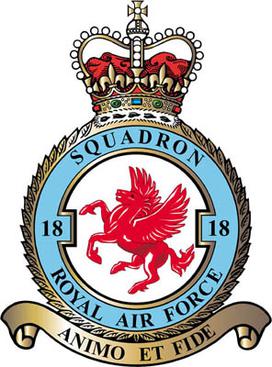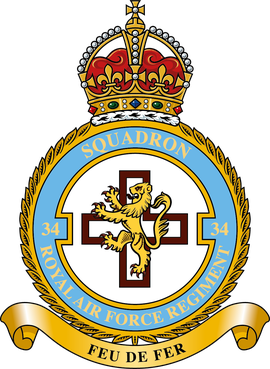
The Falkland Islands are a British overseas territory and, as such, rely on the United Kingdom for the guarantee of their security. The other UK territories in the South Atlantic, South Georgia and the South Sandwich Islands, fall under the protection of British Forces South Atlantic Islands (BFSAI), formerly known as British Forces Falkland Islands (BFFI), which includes commitments from the British Army, Royal Air Force and Royal Navy. They are headed by the Commander, British Forces South Atlantic Islands (CBFSAI), a brigadier-equivalent appointment that rotates among all three services.

The Royal Air Force Regiment is part of the Royal Air Force and functions as a specialist corps. Founded by Royal Warrant in 1942, the Corps carries out soldiering tasks relating to the delivery of air power. Examples of such tasks are non-combatant evacuation operation (NEO), recovery of downed aircrew, and in-depth defence of airfields by way of aggressively patrolling and actively seeking out infiltrators in a large area surrounding airfields. In addition the RAF Regiment provides Joint Terminal Attack Controllers (JTACs) to the British Army in the Tactical Air Control Party (TACP) role, and provides flight size commitment to the Special Forces Support Group.

Royal Air Force Chivenor, or more simply RAF Chivenor, was a Royal Air Force station located on the northern shore of the River Taw estuary, on the north coast of Devon, England. The nearest towns are Barnstaple and Braunton.

No. 18 Squadron of the Royal Air Force operates the Boeing Chinook from RAF Odiham. Owing to its heritage as a bomber squadron, it is also known as No. 18 (B) Squadron.

Number 31 Squadron, known as the Goldstars, is a squadron of the Royal Air Force. The Squadron lays claim to being the first military unit to fly in India, where it was based from 1915 to 1947. Throughout the Cold War, No. 31 Squadron was based in West Germany, flying from RAF Laarbruch and RAF Brüggen. Between September 1984 and March 2019, the Goldstars operated the Panavia Tornado GR1/4, initially from RAF Brüggen and after August 2001 from RAF Marham, Norfolk. No. 31 Squadron was disbanded on 14 March 2019 at RAF Marham and reformed on 11 October 2023 at RAF Waddington, Lincolnshire, equipped with the General Atomics Protector RG1.

No. 603 Squadron is a squadron of the Royal Auxiliary Air Force, based in Edinburgh, Scotland. On reforming on 1 October 1999, the primary role of 603 Squadron was as a Survive to Operate squadron, as well as providing force protection.

No. 1 Squadron RAF Regiment is a field squadron of the RAF Regiment in the Royal Air Force. Its mission is protection of RAF bases from ground attack, and patrolling a large area around main operating bases abroad, in order to defend aircraft on ingress and egress from surface to air attack. It is currently based at RAF Honington.

The Royal Auxiliary Air Force (RAuxAF), formerly the Auxiliary Air Force (AAF), together with the Air Force Reserve, is a component of His Majesty's Reserve Air Forces. It provides a primary reinforcement capability for the regular service, and consists of paid volunteers who give up some of their weekends, evenings and holidays to train at one of a number of squadrons around the United Kingdom. Its current mission is to provide trained personnel in support of the regular RAF.

The 5th Infantry Brigade was a regular infantry brigade of the British Army that was in existence since before the First World War, except for a short break in the late 1970s. It was an Airborne Brigade from the early 1980s until amalgamating with 24th Airmobile Brigade, in 1999, to form 16 Air Assault Brigade.

The II Squadron RAF Regiment is a Field Squadron of the RAF Regiment based at RAF Brize Norton. Some of its gunners receive parachute training.

No. 504 Squadron was one of the Special Reserve Squadrons of the Auxiliary Air Force, and today is a reserve force of the RAF Regiment. It was integrated into the AAF proper in 1936. Based at RAF Cottesmore, Rutland, 504 Squadron used a variety of light bombers before being re-tasked to fighters with the Hawker Hurricane in 1939. It subsequently became a Fighter Squadron. Currently No. 504 Squadron no longer has a flying role, but as part of No 85 Expeditionary Logistics Wing of the RAF A4 Force.

No. 26 Squadron RAF Regiment was an RAF Regiment Field Squadron between 1951 and 2008. It was reformed in 2010 as a specialist Chemical, Biological, Radiological and Nuclear (CBRN) Squadron initially based at RAF Honington in Suffolk. When it was a Field Squadron, it served at locations such as RAF Abu Sueir, RAF Habbaniya, RAF Amman, RAF Tymbou, RAF Nicosia, RAF Changi, RAF Bicester, RAF Gutersloh and RAF Laarbruch. It took part in Operation's Granby and Desert Storm in 1990-91 and latterly it was based at RAF Waddington as a Rapier Squadron.

No. 15 Squadron RAF Regiment is a field squadron of the RAF Regiment in the Royal Air Force. Its mission is protection of RAF bases from ground attack. The squadron's headquarters is at RAF Marham, having moved from RAF Honington.

No. 27 Squadron RAF Regiment was a CBRN squadron of the RAF Regiment in the Royal Air Force with the Defensores Defendo. It disbanded in October 2021.

No. 34 Squadron RAF Regiment is a C-UAS Sqn of the RAF Regiment in the Royal Air Force. Its mission is to detect, track, and ultimately disrupt and destroy unmanned airborne vehicles. The squadron's current HQ is at RAF Leeming. The motto of the squadron is "Feu de Fer "(Fire from Iron).

No. 237 Squadron was a Royal Air Force aircraft squadron. During the Second World War the unit was formed from No. 1 Squadron Southern Rhodesian Air Force for operations in North Africa.
No. 2623 Squadron RAuxAF Regiment is a Royal Auxiliary Air Force RAF Regiment reserve squadron based at RAF Honington. It was formed on 1 July 1979 to provide ground defence of the station. Tasked with preventing Soviet Special Forces from disrupting flying operations, personnel were recruited from across East Anglia and formed an integral part of the station's war-fighting capability for the next 15 years. Throughout this period, the squadron participated in many exercises and held annual camps in the United Kingdom, Germany and Gibraltar, winning the Strickland Trophy competition in 1991.
No. 2503 Squadron RAuxAF Regiment is a Royal Auxiliary Air Force RAF Regiment reserve squadron based at RAF Waddington, in Lincolnshire, fairly close to the city of Lincoln and RAF Cranwell. Gunners are recruited both from ex-regulars in the RAF Regiment and civilians in a 50 miles radius surrounding RAF Waddington. The squadron is an infantry squadron in the dismounted close-combat force protection role. The squadron consists of two Flights of RAF Regiment personnel and one Flight of RAF Police personnel.
At the end of the Cold War in 1989, the Royal Air Force (RAF) structure was as follows:
No. 37 Squadron RAF Regiment was a Ground Based Aircraft Defence (GBAD) squadron of the Royal Air Force Regiment. The squadron operated mostly outside the United Kingdom since its formation in 1951 until 2006 when it was disbanded. It started out as a field squadron before becoming involved in the GBAD programme, where it operated the Rapier missile system.
















